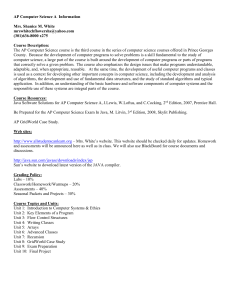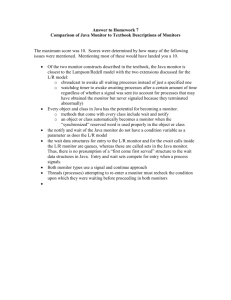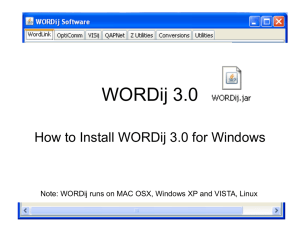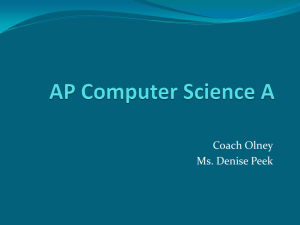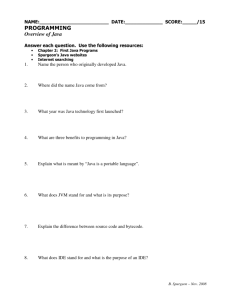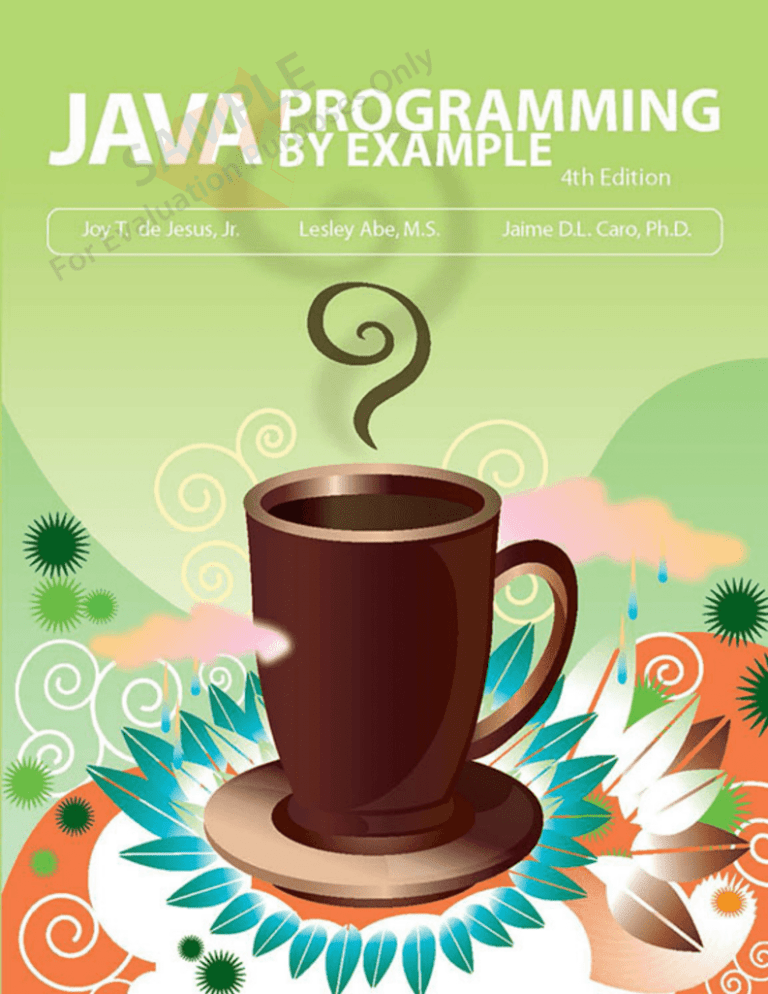
JAVA™
PROGRAMMING
by Example
4th Edition
Joy T. de Jesus, Jr.
Lesley Abe, M.S.
Jaime D.L. Caro, Ph.D.
i
Philippine Copyright 2012
THJV-2015 copyright page update.indd 1
2/26/15 7:32 PM
Trademark of TechFactors Inc.
Philippine Copyright 2012 by TechFactors Inc.
All rights reserved. No part of this courseware may be reproduced or copied in any form,
in whole or in part, without written consent of the copyright owner.
Fourth printing of the fourth edition, 2015
ISBN 978-971-0550-57-9
Published by TechFactors Inc.
Printed in the Philippines
Authors Joy T. de Jesus, Jr. and Lesley Abe, M.S.
Series Editor Jaime D.L. Caro, Ph.D.
Cover Design Jiyas P. Suministrado
Content and Editorial Alvin Ramirez, Frances Ibañez, Joanne Ortiz, and Alexander Lim
Creatives Jiyas Suministrado, Gilbert Lavides, and Regina Zapata
Systems Kim Benebese, Caselyn Dionisio, and Mark Abliter
Exclusively distributed by TechFactors Inc.
101 V. Luna Road Ext., Sikatuna Village
Diliman, Quezon City
1101 Philippines
Telephone number: (632) 929 6924
E-mail address: info@techfactorsinc.com
Website: www.techfactorsinc.com
Exclusively distributed by TechFactors, Inc.
101 V. Luna Road Ext., Sikatuna Village
Quezon City, 1101 Philippines
Sun Microsystems and Java are trademarks or registered trademarks of Sun Microsystems, Inc. in the
United States and other countries. All other trademarks are registered trademarks of their respective
companies.
ii
Philippine Copyright 2012
THJV-2015 copyright page update.indd 2
2/26/15 7:32 PM
FOREWORD
We live in an age of marvels.
Nowadays, we can move machines with the touch of a button. We can
communicate with people halfway across the world in real-time. Innovations occur
everyday because of technology.
For adolescents today, technology is already a part of daily living. They use
mobile phones, computers, iPods, and other electronic gadgets that assist and
expand their awareness of the world. However, they have so much more to learn
about the full potential and limitations of the technology within their reach.
In an increasingly computer-dependent world, it is important to be aware of
the changes in computing technology, and to be knowledgeable in the various ways
that computers can help us in everyday life. This courseware is not only intended
to be an instructional manual discussing individual topics, but also to be a means
of exploring the continually improving and expanding world of computers – and
our society as well.
Jaime D.L. Caro, Ph.D.
Series Editor
iii
Philippine Copyright 2012
THJV-2015 copyright page update.indd 3
2/26/15 7:32 PM
ABOUT THE AUTHORS
Joy T. de Jesus, Jr. specializes in ATM-based and ATM-related systems. He has
served as trainor and content developer of Techfactors Inc., co-authoring the
following books: Office Productivity, IT Project Management, Java Programming
By Example, Animation in a Flash, and C++ Programming Fundamentals. He
studied Computer Science major in Software Technology at De La Salle University
and pursued further studies at Mapua Information Technology Center.
Lesley Abe, M.S. holds the degree of Master of Science in Computer Science
from the De La Salle University. She graduated cum laude with a bachelor’s
degree in Information Technology from the Polytechnic University of the
Philippines. She is an experienced educator in Computer Science and Information
Technology. She is currently a full-time professor at the College of Computer
Studies in De La Salle University.
ABOUT THE SERIES EDITOR
Dr. Jaime D.L. Caro has more than 20 years of experience in education
and research in the areas of Computer Science, Information Technology,
and Mathematics. He received the degrees of Bachelor of Science major in
Mathematics (cum laude) in 1986, Master of Science in Mathematics in 1994,
and Doctor of Philosophy in Mathematics in 1996, all from the University of
the Philippines Diliman. He spent a year as a post doctorate research fellow
at the University of Oxford from 1997 to 1998. He is presently Assistant
Vice President for Development of the University of the Philippines, Program
Director of the UP Information Technology Training Center (UP ITTC), and a
professor of Computer Science in UP Diliman. He is an honorary member of the
Philippine Society of Information Technology Educators (PSITE), President of
the Computing Society of the Philippines (CSP), and a member of the Technical
Panel on Information Technology Education of the Commission on Higher
Education (CHED). Dr. Caro is a recognized expert on Complexity Theory,
Combinatorial Network Theory, Online Communities, and e-Learning.
iv
Philippine Copyright 2012
THJV-2015 copyright page update.indd 4
2/26/15 7:32 PM
TABLE OF CONTENTS
Lesson 1: Introduction to Java™3
Design Goals Behind the Java Language
Versions of Java
Lesson 2: Your First Java™ Program11
Programming Java with BlueJ
Creating Java Programs with BlueJ
Compiling Your Program Using BlueJ
Executing Your Program Using BlueJ
What Can Go Wrong and Some Common Programming Errors
Analyzing Welcome.java
Analyzing Main.java
Lesson 3: Java™ Keywords, Identifiers, Data Types, and Casting25
Java Keywords
Identifiers
Data Types
Variables
Constants
Casting
Lesson 4: Java™ Operators35
Operators
Operator Precedence
Lesson 5: Decisions49
If Statement
If-Else Statement
Nested-If Statement
Switch Statement
Lesson 6: Loops59
For Loop
While Loop
Do-While Loop
Nested Loops
v
Philippine Copyright 2012
THJV-2015 copyright page update.indd 5
2/26/15 7:32 PM
Lesson 7: Exceptions69
Error-Handling
Try and Catch Statements
Lesson 8: Classes79
Classes
Methods
Inheritance
Method Overloading
Overriding
Lesson 9: Arrays99
Single-Dimensional Arrays
Array of Objects
Lesson 10: Building Java™ Programs with GUIs109
Containers
vi
Philippine Copyright 2012
THJV-2015 copyright page update.indd 6
2/26/15 7:32 PM
INTRODUCTION
In this module, the student will find object-oriented programming using
Java™ enjoyable. Basic Java concepts and principles are discussed, alongside with
the explanation of sample executable programs. The student does not need prior
knowledge of any programming language to understand Java. And learning Java
does not end after going through this courseware. Additional information, samples,
and references can be found in various resources such as the Internet.
LEARNING GOALS
By the end of this courseware, the student is expected to:
1. Appreciate Java as a programming language.
2. Define commonly used terms in object-oriented programming such as
classes and objects.
3. Apply the different language elements and constructs of Java to solve simple
programming problems.
FORMATTING CONVENTIONS
Italics – used to distinguish filenames, directories, or class names
Boldface – used to indicate important terms in the lesson
Courier – used to represent Java syntaxes
DISCLAIMER
Every effort has been made to make this courseware as accurate as possible,
but no warranty or fitness is implied. The authors and publishers shall have neither
liability nor responsibility to any person or entity with respect to any loss or
damage arising from the information contained herein.
1
Philippine Copyright 2012
THJV-2015 copyright page update.indd 1
2/26/15 7:32 PM
LESSON ONE
It is a truth universally acknowledged, that a single man in possession of a
large fortune must be in want of a wife.
However little known the feeling or views of such a man may be on his
first entering a neighborhood, this truth is so well fixed in the minds of the
surrounding families, that he is considered the rightful property of someone or other
of their daughters.
– from Pride and Prejudice, Jane Austen
THJV-2015 copyright page update.indd 2
2/26/15 7:32 PM
Introduction to Java™
Part of the courtship rituals in 19th century England was
that women of a certain class were expected to marry men who
were within their social and financial means. They were paired
with possible husbands who were thought to be best suited to
their lifestyle and the lifestyle to which the men’s families were
accustomed. Qualities were compared and contrasted, and
similarities were highlighted while differences were discarded.
LESSON OBJECTIVES
At the end of this lesson, the
student will be able to:
1. Describe the history of
Java.
2. Explain the design goals
behind Java.
The Java programming language initiative started in 1991
and was spearheaded by a group of engineers from Sun
Microsystems named the “Green Team,” led by James Gossling.
The Green Team envisioned that the next big thing was the union
of consumer devices and computers. To demonstrate this, they
created an interactive home entertainment controller targeted for
cable television. Unfortunately, the concept was too advanced for
its time, but Java was soon integrated into one of the more
popular original Internet browsers, the Netscape Navigator in
1995, ushering Java into the mainstream development. With its
“Write Once Run Anywhere” principle, within a few years, Java
became one of the programming languages with the fastest
growing developer base. With the acquisition of Sun
Microsystems by Oracle Corporation in around 2009-2010,
Oracle has since described itself as the steward of Java technology.
3. Identify various Java
versions.
LESSON OUTLINE
1. Design Goals Behind the
Java Language
2. Versions of Java
Like many programming
languages, Java had several names
before the developers finally settled
for one. Java was once named “Oak”
since there was an oak tree outside the
NOTE
engineers’ office. Then the language
was named “Green,” until finally, the
team settled for “Java,” since they were consuming a lot of
Java coffee during the course of their development.
3
Philippine Copyright 2012
THJV-2015 copyright page update.indd 3
2/26/15 7:32 PM
Introduction to Java
Design Goals Behind the Java Language
Simple, Object-Oriented, and Familiar
One of the goals of the Java developers was to create a simple programming language
that can be used even without extensive programmer training. An example that attests to Java’s
simplicity are concepts such as automatic memory allocation and automatic garbage collection.
In some programming languages, the developer is required to program the amount of memory
allocated to elements of the program and proper “garbage collection” from the program’s
functions. Programming these takes a lot of time and effort. With Java, all these are done in the
background, thereby freeing the programmer to think of other things related to the program.
The developers of Java also wanted the programming language to be familiar, that is,
to look as close to C++ as possible when it comes to language syntax, but removed certain
complexities of C++. C++ remains to be one of the more popular programming languages to
date, so having Java “look and feel” like C++ encourages more developers to try out the Java
programming language and create programs faster.
Object-oriented programming (“OOP” for short) was conceived to model real-world
objects. In OOP, a class defines the common variables (attributes) and methods (functions)
of a set of objects. An object is an instance of a class. For example, all humans have common
attributes: name, age, birthday, etc.; and functions: getting old or growing up. Once you
understand how components of a program are treated as objects, you will find Java fairly simple.
In addition, using other predefined and more complex components will be effortless once they
are implemented and utilized in the same way.
CLASS
OBJECT
name Andres Bonifacio
age 33
birthday
November 30, 1863
Robust and Secure
Java has a certain degree of fault-tolerance, which is a property that allows a platform to
continue to function in the event of a failure or an error. Java also has good exception handling
when running your program. Even after you compile your program, the Java Virtual Machine
performs security checks when executing the code.
Java was created to run in various environments, even in those where security is a top
concern. To address this, Java lets you construct network applications that can be secured from
intrusion by unauthorized code attempting to invade the network.
4
Philippine Copyright 2012
THJV-2015 copyright page update.indd 4
2/26/15 7:32 PM
Introduction to Java
Architecture Neutral and Portable
Earlier we mentioned that Java adheres to the “Write Once Run Anywhere” principle.
This means that Java was designed to create applications that can execute in different operating
systems, hardware architectures, and network environments by ensuring that the programming
concepts and behavior are the same on every platform without any data incompatibilities. Java is
able to accomplish neutrality and portability through the Java Application Programming
Interface (Java API) and the Java Virtual Machine.
The Java API is the component that
allows you to write your program. The Java
API can be used with Integrated Development
Environments (IDEs) such as Net Beans,
Eclipse, and BlueJ to make programming easier.
If you have used other programming languages
before, once you compile your program, you
should be able to run it right away on your
computer as an executable file. With Java, the
compiler generates “bytecode” files which is an
architecture neutral format used to transport
code across various hardware and software
platforms, and even various versions of the Java
programming language.
Java code
(*.java)
Java Compiler
bytecodes
(*.class)
Java Virtual Machine
iOS
Windows
Linux
Mobile
Phones
Various platforms (i.e. Windows, Linux,
Java codes written once can be executed almost anywhere.
iOS, etc) can have different implementations
of the Java Virtual Machine but there is only one Virtual Machine specification. Because of this,
Java is able to have a uniform programming interface and can run the bytecode file anywhere.
High Performance
High Performance Computing (HPC) are applications that aim to solve complex
computational problems. Certain characteristics of Java make it an ideal candidate to program
high performance computing applications. Since hardware advancements keep on moving
forward, having the latest and faster hardware helps HPC performance. HPC applications
must then be portable to adapt to constant hardware upgrades. HPC applications are normally
running within a network or via distributed computing and Java has built-in support for
distributed systems.
Interpreted, Threaded, and Dynamic
By “interpreted,” we refer to how the Java bytecodes are interpreted by the Java
Virtual Machine regardless of the hardware and software platforms. Java’s interpreted nature
5
Philippine Copyright 2012
THJV-2015 copyright page update.indd 5
2/26/15 7:32 PM
Introduction to Java
has been discussed earlier but one of the benefits of having an interpreted language is faster
development cycles.
Java is also a multithreading programming language that allows the programmer to build
applications with many concurrent activity threads. Multithreading allows a program to execute
many tasks at the same time. This reduces the execution time and improves the performance of
the application.
Big projects and applications require several programmers collaborating together. In most
cases, a team of programmers can develop one part of the application that will be integrated with
another team’s work. But what if there are updates to one team’s work? Those updates have the
ability to mess up the work of other teams who have integrated the old application. Java makes
it possible to reuse previously written program to lessen the workload of the programmer. Aside
from this, it also allows programmers to make revisions, additions, and alterations to a program
without affecting other programs that might already have been using it.
Versions of Java
We can learn more about what kind of applications use Java by knowing the different
versions of Java available:
Java Standard Edition (JSE) – This is the default Java version that allows us to develop
applications for desktops, servers, and small embedded environments such as SIM cards and
SMART cards. It also provides the creation of a rich user interface. These applications serve a
small number of users at a time.
Java Enterprise Edition (JEE) – Applications created for this version of Java are oriented
towards enterprise software catering to data-intensive server applications meant to have a large
number of users. While JSE can also run on servers, JEE is tailor-fit to handle network and web
applications.
Java Micro Edition (JME) – Applications using JME are normally mobile devices such as
mobile phones and other embedded devices such as Blu-ray players, TV boxes, and printers. JME
applications can run on many devices but also highlight key features of the device.
6
Philippine Copyright 2012
THJV-2015 copyright page update.indd 6
2/26/15 7:32 PM
SCORE
L1
JAVA PROGRAMMING
Introduction to Java
NAME:
SECTION:
DATE:
Match the Java related concepts with their corresponding meanings.
SKILLS WARM-UP
1. Java
2. Object-Oriented
Programming
CUT THIS PAGE
3. Dynamic
a. feature that allows the making of revisions, additions and
alterations to a program without affecting other programs
that might already have been using it
b. describes applications that can execute in different
operating systems, hardware and network environments
c. the result of compiling Java code with a Java SDK
4. Object
d. the software that executes compiled Java codes
5. Bytecodes
e. a feature that allows a program to perform several
functions at the same time
6. Multithreading
f. an instance of a class
7. BlueJ
g. describes applications that aim to solve complex
computational problems
8. High Performance
h. a programming paradigm that was conceived to model
real world objects
9. Architecture Neutral
i. an object-oriented programming language that was
created by engineers of Sun Microsystems
10. Java Virtual
Machine
j. a type of Java Integrated Development Environment to
aid programmers in coding
7
Philippine Copyright 2008
THJV-2015 copyright page update.indd 7
2/26/15 7:32 PM
SKILLS WARM-UP
Take a look at the following statements below. Write True on the blank
provided if the statement is true, otherwise write False.
__________ 1. The Java programming language makes object-oriented programming
easier.
__________ 2. JME is tailored to create networked applications.
__________ 3. It is possible to reuse Java code previously written for other projects.
__________ 4. It is possible for a Java class compiled in an Apple iOS machine to
be executed in a Windows environment provided that the Java Virtual
Machine is properly installed.
__________ 5. The Java Virtual Machine can access and modify any file on your
computer.
__________ 6. Java bytecodes are executable on their own
__________ 7. Programmers still need to program garbage collection and memory
allocation in Java for their individual programs.
__________ 8. The two main components of Java are the Java Application Programming
Interface and the Java Virtual Machine.
__________ 9. The Java Virtual machine no longer performs security checks when
executing the code.
__________ 10. Java was created to look and feel like C++.
8
Philippine Copyright 2008
THJV-2015 copyright page update.indd 8
2/26/15 7:32 PM
Introduction to Java
One popular misconception is when people assume that
the mobile operating system Android runs on Java or JME. In fact,
Android has its own virtual machine separate from the Java versions
known as “Dalvik.” This means that regular Java bytecode cannot be
interpreted by the Dalvik Virtual Machine in the same way as JME
NOTE
or JSE. To get your Java program to work with Android, you need to
compile it using the Android SDK. The usage of the Dalvik Virtual Machine is currently
a point of discussion in the ongoing patent litigation between Oracle and Google, the
creators of the Android OS.
SUMMARY
Java is an object-oriented language. In this paradigm, objects
are class instances. Like other object-oriented languages, you can reuse
codes and create dynamic applications. Moreover, you can use its
extensive built-in library to create a wide variety of programs.
High Performance Computing - applications that aim to solve
complex computational problems
Java Virtual Machine - software that executes Java codes
WORD BANK
GROUP WORK
Multithreading - allows a program to execute many tasks at the
same time
Java as a programming language has found applications in
many fields in computer science. Some Web sites use Java applets
to provide interactive games or animated Web navigational buttons.
Some software projects use Java to aid to model and simulate artificial
intelligence or aid in mathematical computations.
Your task is to create a group composed of five students to
do some group research work to find three software projects or websites that use Java.
If possible, give the URL of the websites that use Java applets or the homepage of the
projects that use Java. Try to find out how the benefits of Java, discussed in this lesson
helped these applications provide their specific services and requirements. Present the
results of your discussion in class for additional insights.
9
Philippine Copyright 2012
THJV-2015 copyright page update.indd 9
2/26/15 7:32 PM
THIS IS A SAMPLE COPY
To purchase the full version of this book, go to
www.techfactorsinc.com/store
www.techfactorsinc.com

